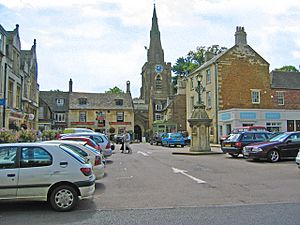Church of St Peter and St Paul, Uppingham facts for kids
The Church of St Peter and St Paul is a special church in Uppingham, Rutland, England. It's a Church of England church, which means it's part of the main Christian church in England. This church is dedicated to two important saints, St Peter and St Paul. It's a place where people in Uppingham have gathered for worship and community events for many years.
Quick facts for kids Church of St Peter and St Paul, Uppingham |
|
|---|---|

Church of St Peter and St Paul, Uppingham: glowing in the early morning winter sun, the church is seen from the southeast corner of the churchyard
|
|
| Denomination | Church of England |
| Churchmanship | High Church |
| Website | www.uppinghamchurch.co.uk |
| History | |
| Dedication | St Peter and St Paul |
| Administration | |
| Parish | Uppingham |
| Diocese | Peterborough |
| Province | Canterbury |
Church History
This church is a very old and important building. It is listed as a Grade II* building. This means it is a particularly important building of more than special interest. Most of the church was built in the 1300s. It was carefully repaired and updated in 1861 by Henry Parsons.
The church has a tall tower at the west end. It also has a main hall called the nave. On either side of the nave are side sections called aisles. Above the nave is a row of windows called a clerestory. There is also a chancel, which is the area around the altar. The church also has a north chapel, an organ room, and a vestry. There are porches on the north and south sides.
The tower has three levels and a tall, pointed spire. The spire has three rows of small windows called lucarnes. The nave has four sections, and one more section was added during the 1861 repairs. The north aisle was built in a style called Decorated. The south aisle was built in a style called Perpendicular. You can still see old wall paintings on the south arcade. These paintings show red flowers and swirling patterns.
The chancel was rebuilt in 1861. Black marble columns were added to the north chapel, also known as the Lady Chapel, and the organ room. During the rebuilding, some carved pieces from the 1100s were found. Two of these pieces are now part of the wall near the north door. A coffin lid from the 1200s was also discovered.
The church's font was made in 1863. It was designed by George Edmund Street. It was originally made for All Saints' Church in Cottesbrooke, Northamptonshire.
Church Leaders
The church has had many rectors over the years. A rector is the main priest in charge of a parish church. Here are some of the people who have served as rectors:
- Edmund Bonner 1528–1541
- Edward Martin 1631–1637
- Jeremy Taylor 1638–1643
- Edward Jones 1786–1814
- George Hutchinson 1815–1817
- John Giles Dimock 1817–1858
- William Wales 1859–1879
- C. A. Yate 1879–1880
- Prideaux Lightfoot 1880–1906
- Edward Moore (Archdeacon of Oakham) 1907–1920
- John Ivan Willett 1982–1999
- Stephen Evans 2000–2010
- Rachel Watts 2011–current
Church Bells
The church tower holds a set of eight bells. These bells are rung together to make music.
- The smallest bell, called the Treble, was made in 1773. It was made by Pack and Chapman of London.
- The Second bell was also made in 1773 by Pack and Chapman.
- The Third bell was made in 1772 by Pack and Chapman.
- The Fourth bell was made in 1804 by Robert Taylor of St Neots.
- The Fifth bell was made in 1895 by John Taylor & Co of Loughborough.
- The Sixth bell was made in 1772 by Pack and Chapman.
- The Seventh bell was made in 1772 by Pack and Chapman.
- The largest bell, called the Tenor, was made in 1772 by Pack and Chapman.
The Organ
The beautiful wooden case for the organ came from St Mary's Church, Nottingham in 1777. It was built by Thomas Swarbrick in 1742. The organ itself was built by Harrison and Harrison in 1894. It was moved and installed in this church in 2006 by Peter Collins. Before that, it was at All Saints' Church in Eppleton, County Durham. You can find more details about this organ on the National Pipe Organ Register.


